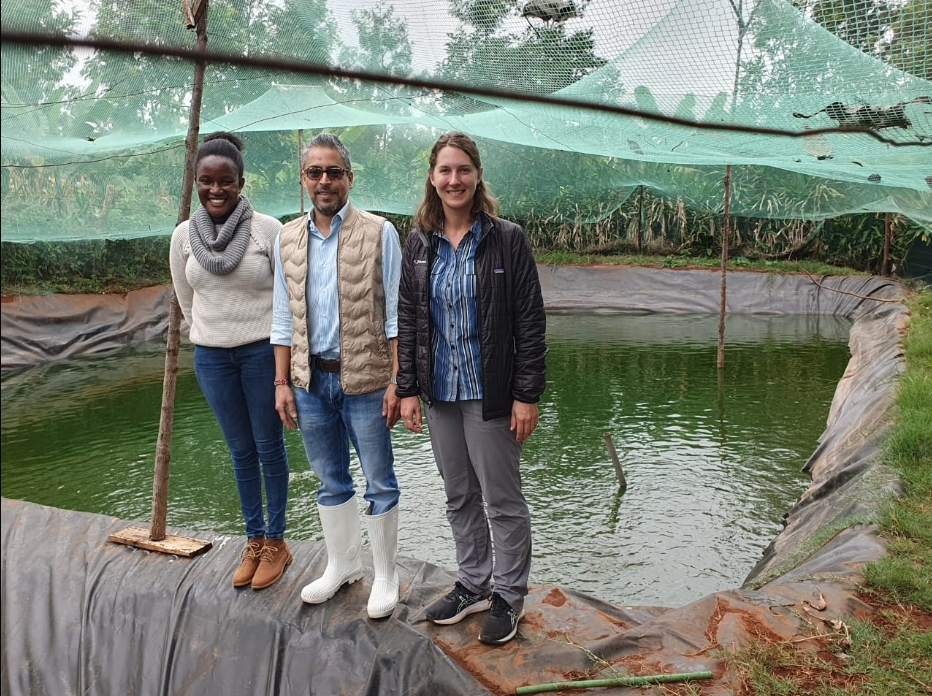Aquaculture is experiencing remarkable growth in Kenya, and in August, our team embarked on an enlightening journey to Kiambu County, where we had the privilege of visiting two fish farms. These visits shed light on the diverse approaches and challenges faced by fish farmers in the area. Let’s delve into the contrasting stories of Murero Tilapia Farm and Peggy Farm, showcasing their practices, successes, and areas for improvement.
Murero Tilapia Farm
Our team met with Mr. Gideon Morai and his wife Regina, who have operated the farm since 1997. They raise tilapia and crayfish, and have plans to introduce catfish as well.
Favourable Findings
Before starting Murero Tilapia Farm, the Morais tested the source water’s quality.
The farmers introduce catfish into each tilapia pond to control the tilapia’s egg population, even though it’s not a perfect solution. The farm operates on an “all in, all out” system, and between cycles, they thoroughly dry and rinse the ponds. They don’t use any chemical treatments.
The farm has not experienced any significant disease, and mortalities are minimal, typically numbering 3-4 per cycle. When a fish dies, it is removed from the pond.
The farm is part of a cooperative of local fish farmers in Gatundu South. Although they do maintain some production records, they admitted that record-keeping had recently fallen behind.
Mr. Morai is self-taught, but has also participated in the Farm Africa program.
The Morais grow a variety of crops, and use wastewater from their fish ponds to irrigate them. They use lined ponds with nets supplied by the county government.
Notable Hurdles
One of the most significant challenges the farm faces is acquiring the necessary capital to establish and maintain their farm. The initial setup requires dams, pond materials, and other essentials. Fingerlings are expensive, and feed is expensive and hard to find.
Currently, the farm is home to around 1,000 fish in their smaller pond and 2,000 in a larger one. These ponds, measuring 8 x 12 meters, are maintained at a depth of 1 meter. This makes the stocking density just under 10 fish/m², although the recommended density is 5 fish/m².
Water for the farm is sourced from a shallow well and pumped using a petrol-powered pump. Mr. Morai would like to switch to solar-powered pumps when he can afford them, to reduce operational costs.
Although they initially had the water tested before the farm opened in 1997, for farming tilapia, they don’t regularly test the water quality. ConcernsThe fish are harvested after about 8 months. They drain water from the pond and then select the larger fish. These fish are gutted while still alive.
Mr. Morai was not familiar with the concept of animal welfare, highlighting the importance of ESR’s upcoming training modules.
Peggy Farm: Innovative Aquaculture Practices
Our second visit took us to Peggy Farm, where we met Sarah and Charles Kungu, owners for the last 18 years. We spoke with Elizabeth, the farm manager for the last two years, who walked us through their innovative practices.
Peggy Farm uses Recirculating Aquaculture System (RAS) setups for catfish, tilapia, and ornamental fish. Aquatic plants are used for filtration in tanks outside the hatchery. Water for the farm comes from a borehole, ensuring a consistent and reliable supply.
Apart from catfish and tilapia, Peggy Farm is also known for its ornamental fish collection, including koi, comet goldfish, fancy goldfish, shubunkin, and cichlids. Although they do sell broodstock, their primary focus is on producing and selling fingerlings.
Currently, they produce approximately 60,000 catfish per month and 50,000 tilapia every 2-3 months.
Peggy Farm uses no chemical treatments or vaccinations. The water is regularly changed every 4-21 days, depending on the fish and the life cycle. They measure ammonia and oxygen levels monthly, and change the water more often if the quality is subpar.
To maintain optimal water temperature, Peggy Farm uses floating heaters, checking water temperature every two hours. They have not faced significant issues with diseases or deformities in their fish. Incoming fish are quarantined for a week, and they have a biosecurity plan (although they lack written protocols).
Peggy Farm maintains detailed records of their operations.
Closing the Net: Reflections on Our Kenyan Fish Farm Visits
Our visits to the Murero Tilapia Farm and Peggy Farm show the contrast between small-scale vs professional fish farming in Kenya. Owners at both farms were open to our suggestions and dedicated to continuous improvement. As we move forward, a vital step will be engaging with organisations like Farm Africa and other aquaculture course providers, urging them to incorporate fish welfare education into their training programs. In doing so, we can contribute to the growth of a more sustainable and ethical aquaculture industry in Kenya, benefitting both farmers and the welfare of the fish they raise.

